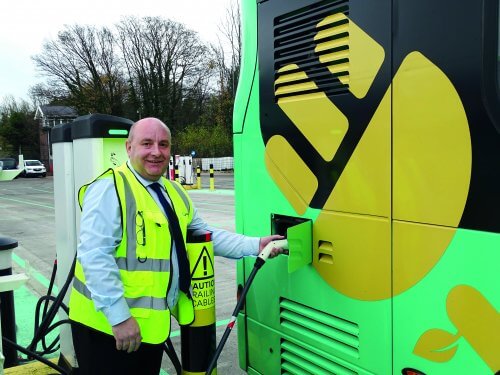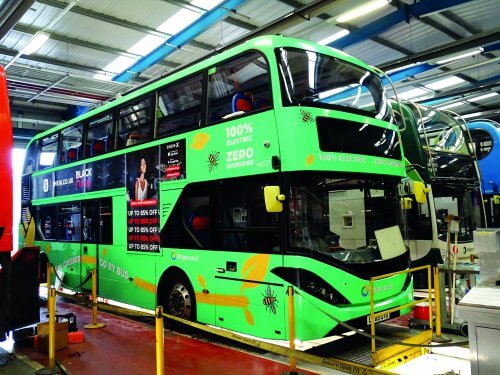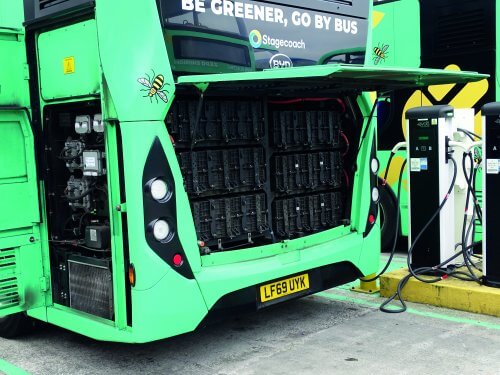
Stagecoach Manchester’s fleet of 32 electric buses is approaching two years of operation this March. Richard Sharman visited Sharston depot to find out about its experience of operating them so far
In March 2020 Stagecoach made one of the single biggest investments in technology anywhere in Europe by introducing a fleet of 32 BYD ADL Enviro400 Citys to help deliver cleaner air for communities in Greater Manchester. They were introduced in partnership with the Mayor Andy Burnham and Transport for Greater Manchester (TfGM) as part of plans to improve air quality in the region and reduce harmful carbon emissions.
By March 2021 the electric double-deckers had achieved 700,000 carbon-free miles operating on services 43 and 111, connecting Manchester city centre with the airport and numerous hospital and university sites. With nearly two years of operation under their belt, Fleet Engineer at Sharston depot, Mark Povall explained the process of introducing electric buses to the fleet from the start, and how they have fared since March 2020.
Depot changes
“Sharston depot was built ten years ago to replace Princess Road depot, which was redeveloped for new housing. We have the most modern depot in Stagecoach Manchester and are proud to be home to the 32 BYD ADL electric buses,” enthused Mark.
[wlm_nonmember][…]
By subscribing you will benefit from:
- Operator & Supplier Profiles
- Face-to-Face Interviews
- Lastest News
- Test Drives and Reviews
- Legal Updates
- Route Focus
- Industry Insider Opinions
- Passenger Perspective
- Vehicle Launches
- and much more!
“In terms of planning to introduce the electric bus fleet to the depot, we first had to look at the infrastructure and plan where it would be best placed. This work was mainly done by our own Engineering Director, Tony Cockcroft. He went through what infrastructure civil engineering work required doing and the charging infrastructure needed.
“The charging infrastructure was to be installed at the far end of the depot parking area, so in effect we had to turn the workshop around. Previously, the workshop area in front of the charging infrastructure was used for running repairs and MOT preparation, but from a health and safety point of view, and to reduce the amount of vehicle movements, we made changes to keep the vehicle movements to an absolute minimum near the vehicle charging area.
“Work then commenced around Christmas time in 2020. What we had to do was create a building site within the depot which was safe, so everything was Harris fenced off and we were having daily meetings with Centrica, who did all the civils, cabling and high voltage transformers, to ensure we knew what thay needed. They also knew what we wanted and if they were working in a certain place they could pull their area in so we could have a little bit more parking. It was very much working together and although Covid-19 started three months later, a lot of the civil work had been done.
“Because we were in a situation where we had reduced peak vehicle requirement due to Covid-19 we were able to move some of the fleet to other depots, although the majority of the fleet renamed on site whilst the work was completed. Luckily our bus wash is located as you come into the depot at the opposite end to the charging infrastructure, which was a godsend really because we were having to send vehicles around the depot. Thankfully we had some really good people. If it wasn’t for those people, we wouldn’t have been able to do what we’ve been able to do. The whole infrastructure thing was embraced by not only the engineers, but the likes of Paul Murphy, Cornel Grant (usually known as ‘Junior’ by colleagues – see page 62 for news of his New Year Honour) and Joanne Morgan. These were the people that were out there managing our traffic on a day to day basis. And if it wasn’t for that the project wouldn’t have been as successful.
“We’ve gone through that this whole infrastructure installation with zero lost time injuries to anybody and no accidents. It has been a smooth transition and that was born out of people’s interests and excitement of getting this new project going.”

Working with Swarco
“Tony had liaised with a number of firms that supply charging facilities and decided that we would go with with Swarco,” explained Mark. “We have found the charging equipment very easy to work with, it’s quite a simple system to be perfectly honest. We’re looking to further enhance the system so we can get some better data and make it easier for the guys that are actually putting the vehicles on charge.
“The clever thing is that we can charge a stacking system, meaning that we could put all 32 buses on charge if they were all in at any one time. The system would then identify which vehicles needed the most charge and charge those vehicles first, then as they get to 95% it slows them down and introduces other vehicles. It’s really good charging system.
Adrian Felton, Swarco Smart Charging’s National Strategic Account Manager for E-Bus and E-Truck, told CBW: “We are delighted to be supporting Stagecoach with its electrification plans and we continue to be 100% committed to working with Tony and his team at Sharston. This has been a fantastic project to work on, but the installation of these 36 chargers was only just the beginning of the project. At Swarco know that the buses and charging infrastructure will be in operation for the next 10 to 15 years, if not more, and so we look forward to supporting the Sharston depot long into the future to ensure that they get the very best out their investment and that we bring value into their business.
“Swarco always sees itself as a long-term innovation partner. So not only will we continue to be on hand to support the Sharston team day-to-day, but we’ll also be developing solutions that will help to meet the evolving needs of Stagecoach. In the background, we’ll also continue to support the advancements of public transport electrification, not least through our engagement with groups such as the Zemo Partnership that aims to move industry standards forward so that charging infrastructure can be used by all categories of vehicle. It will mean that bus operators like Stagecoach can open up their depots to other electric vehicles and generate new revenue streams from their charging infrastructure, as well as supporting other businesses and road users.”
Engineering training
“Everything we do at Stagecoach is about safety, so the engineers working on these vehicles have received significant training,” explained Mark. “The BYD vehicle familiarisation course was quite intensive and goes through quite a lot of information, but because the vehicles are still under warranty we’re not getting involved with anything high voltage at the moment. That’s allowed us the time to get the training in place to ensure that staff are safe.
“Engineers are also going through IMI accredited residential training courses with GTG College in Glasgow. We use this company for training our apprentices; they also have a site in Wolverhampton.
“Faraday training is also provided, which is all about electrical safety. In essence it’s all about proving the electrical systems are dead, and the documentation around that, which proves that we’re working in a safe manner and doing it correctly.
“It doesn’t stop there, we’ve got our own risk assessment, safe systems work and that type of thing. We’ve enhanced that with Health & Safety Executive documents that we’re looking to roll out. We’ve got our own safety board with all the safety tooling with insulated tools, and the rubber mats, the gloves, the rescue poles and so on.
“We also have safety signage, permits to work, transfer of duty paperwork for two people are working a vehicle. It’s all about proving that the system is dead and that there is no residual current left in the system or drive motors. So we’ve done a lot of work on the health and safety side of it to make sure that our employees are safe and all know, categorically how to shut the vehicle down.
“In the future we’re hoping that we will have our own capability to carry out things like replacing battery cells. If we are not at that point when they require changing there are other people within the industry that we can call, but I’m hoping that we will be in that position to be able to do that work when required.”

EV misconceptions
“When it comes to the vehicle inspection itself on the BYD ADL Enviro400 City, the front axle remains the same, you’ve got no engine or gearbox so the the actual 28-day inspection is less involved in that in that context, but the actual service of the vehicle when it comes to fluids is more robust, so that in turn tends to be a more time consuming. You have got a drive motor and a hub on either side, and motor oils that need changing, plus compressor oils that need changing every three months, so although the inspection side has got a little bit quicker, the servicing side is a more time consuming. There is also air-conditioning fitted to these vehicles so there are also filters to change at regular intervals.
“We report any warranty work that needs doing through ADL, which then sends it on to BYD. In addition we normally have a BYD engineer on site every day to address any issues that we might have.”
Driver experience
Bus driver Paul Murphy has been part of the Sharston team for nine years. He has been on rota that drives the BYD ADL electric buses since they arrived. We asked him what his experience of the vehicles have been over the last 12 months: “They are nice smooth and quiet vehicles to operate, with the air-conditioning making a huge difference in the summer months. From a drivers point of view you do have to adapt your driving style due to the weight of the vehicle and the regeneration of the batteries when braking and taking your foot off the accelerator, but you go home after a day on the road with them and you feel relaxed. I love driving them.
“Passenger reaction from the very start has also been that they prefer the smooth ride in comparison to the diesel buses previously used on the two routes.”
No range anxiety
“When fully charged we expect the vehicles to have a range of 150 miles, and service 43 operates 24/7, so we have got enough capacity to keep the vehicles on there. When the peak vehicle requirement drops in the daytime we can get buses back and charge them ready for the night service. Other buses will come back during the morning relief as the early bus leaves about 0400hrs in the morning, that’ll go out and then the another one will come back, and then they’ll go on charge, so it’s all done in rotation” explained Mark.
“If a vehicle falls below 20-25% the driver puts a call into the depot and we’ll arrange a changeover and get the vehicle back to the depot to recharge. Weather dependent, because of the heating system, vehicles normally return to the depot after a full day on a running board with 30-35% to spare.”
“We have the ability to monitor every vehicle on charge via a screen in the Traffic Department or from key staffs’ laptops, so if one decides to shut off we are immediately alerted and we can go out to it, so we should never be in a position where we are saying ‘why isn’t that bus charged?’ We cannot see the charge of the vehicle on the road, but there may be plans to look into doing that through telematics. The vehicles have been very reliable and we are very pleased with them. We are expecting a 15-year lifespan from them.
“Not only are we saving on diesel, but a huge reduction in carbon emissions. On average, there’s a CO2 saving of 81 tonnes per vehicle, so over the 15-year lifespan of the project, we will produce 39,000 tonnes less CO2 compared to a Euro IV diesel bus. So it’s quite significant in the fact that we are helping to save the planet,” Mark said enthusiastically.

Working with BYD and ADL
Frank Thorpe, Managing Director at BYD (UK) commented: “BYD strongly believes in the value of partnerships, especially in evolving clean zero-emission solutions for public bus transport. Our successful electric bus collaboration with ADL in the UK and the service we collectively provide to Stagecoach underpins our rationale behind this philosophy. Our combined strengths and areas of expertise, which brings BYD’s pioneering battery and electronic technology to the partnership, have enabled us to effectively support Stagecoach Manchester at a pivotal time of change. The substantial pure-electric Stagecoach fleet of emission-free BYD ADL Enviro400EV buses has demonstrated reliability and efficiency on busy bus routes within the Greater Manchester area. We commend Stagecoach on proactively addressing the issue of air pollution, while also enhancing the appeal of public bus transport through high quality services, and we are pleased to be part of that journey.”
Paul Davies, President & Managing Director of Alexander Dennis added: “As the UK continues to deal with the impact of the coronavirus pandemic, we cannot lose sight of the effects that transport choices have on the twin challenges of the climate emergency and air pollution. It is more imperative than ever to ensure that buses are an attractive choice with high quality services underpinned by appropriate priority and infrastructure, and delivered with state-of-the-art low and zero-emission buses built in this country.”
Road to Renewables tour visits Sharston
Sharston depot played host to the COP26 Road to Renewables pure electric double-decker last October. The COP26 branded vehicle visited the site on Monday 25 October, on day six of an 11-day nationwide tour, which had seen the electric vehicle travel from London to Glasgow, marking the COP26 climate change summit by showcasing examples of the national effort underway to decarbonise energy and transport.
In Manchester, the bus highlighted the need to work towards its net zero ambitions for the future, showcasing the multi-modal electric vehicle charging infrastructure. Vehicles from small to large were charged simultaneously during the visit, to illustrate how shared infrastructure will be crucial in the future of net zero transport.
Stagecoach has committed to the United Nations-backed Race to Zero initiative with a commitment to set stretching science-based carbon reduction targets. It has also joined the Business Ambition for 1.5°C campaign, the world’s largest and fastest-growing group of companies that are helping to halve global emissions by 2030. The initiative is designed to provide a clearly defined pathway for companies to reduce their greenhouse gas (GHG) emissions in line with what is necessary to meet the goals of the 2015 Paris Agreement on climate change. Stagecoach has committed to the highest level of ambition in both the short and long-term by aligning its ambition with keeping global warming to 1.5°C and reaching science-based net-zero emissions by 2050.
As part of its recently launched Sustainability Strategy, the company is working on a roadmap to become a carbon neutral business by 2050 and will advocate for policy measures by Government to deliver a net-zero emissions economy. As well as firm targets around zero emissions, the new strategy includes initiatives to further reduce waste, conserve water and minimise energy use.
Stagecoach has invested more than £1billion in greener vehicles over the past decade. It has committed to target a fully zero-emission UK bus fleet by 2035, and is introducing 46 new fully electric buses in Scotland as part of the Government’s Ultra Low Emission Bus Scheme.
Speaking of Stagecoach’s commitment to a greener future, Lee Wasnidge, Managing Director of Stagecoach Manchester said: “We’re thrilled that our Sharston depot, the home of the region’s first double-decker bus fleet, was a stop on the COP26 Road to Renewables tour.
“As part of the national effort already underway to decarbonise energy and transport, Stagecoach has already made significant steps to target a zero-emissions bus fleet across the UK by 2035. However, achieving net zero is about much more than just switching technology. We need to change how we live, making less use of cars and switching to more sustainable public transport, cycling and walking. This along with what we have set out in our strategy is vital if we are to meet the objectives of COP26.
“Maximising the benefit of investment in electric charging infrastructure by making facilities available to other fleet users, such as logistics companies, could help accelerate decarbonisation. This would complement the wider opportunities to cut carbon emissions and reduce local air pollution.”



